Bright, tangy, and creamy, a smooth curd is one of the most versatile spreads to have on hand.
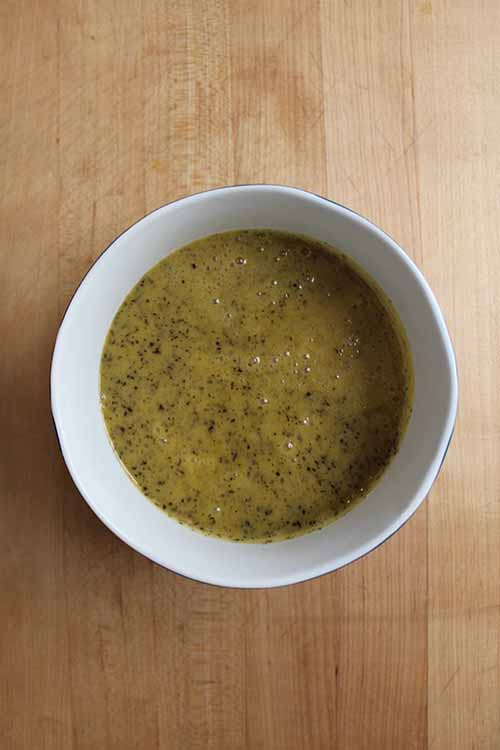
Scooped atop a bowl of yogurt, served as a dip for strawberries, slathered onto warm, flaky scones, or eaten straight with a spoon, it never hurts to keep a jar of curd in the refrigerator.
While some decent pre-made varieties are available at the store, nothing beats a homemade curd, cooked with freshly pressed juices – not to mention the variety of flavor options available when you do it yourself!
What flavor tickles your fancy? Acidity is key
In a curd, the acid in the juice reacts with sugar to slowly cook egg yolks, creating a smooth, creamy texture. Almost any fruit juice can make a flavorful curd, but a higher acidity helps to form a better texture.
Try mixing lower acidity fruits with citrus to bring up the pH. An easy way to judge is according to tartness – if your juice doesn’t have much tang, throw in some lemon or lime.
It’s fun to mix up the flavors by adding herbs or teas to the mix as well.
Some great fruit options:
Tips for making a smooth curd:
- Whisk together the eggs and sugar before adding in the fruit juice. The sugar will keep the acidic juice from instantly curdling the eggs.
- Cook your curd over a double boiler. This has two purposes:
- First, it is easier to control the temperature of your curd when cooked over a double boiler. By allowing steam to do the work rather than relying on direct heat, you slow down the process, more evenly distribute the heat, and in turn decrease the chances of curdling your eggs.
- But secondly, the reaction between the acidic juice and some pots (like cast iron and copper – you can read more about these types of pans here) can leave a metallic taste in the curd. While this can be resolved through the use of a nonreactive pot, I prefer a double boiler just to be safe.
- Stir your curd continuously with a rubber spatula. Be sure to scrape the bottom of the bowl as well as the sides, to cook the entire curd evenly.
- After the curd finishes cooking, it’s time to add some butter. Once it has melted, buzz the curd with an immersion blender or pass through a chinois to smooth out the texture. The best way to be sure that the butter has fully emulsified into the curd is to mix it with an immersion blender.
- If you don’t have one, however, passing the mixture through a chinois or a strainer can help to finish incorporating the butter as well. Otherwise, your cooled curd might have a slightly grainy texture.
The Recipe
- 1/3 cup hot water
- 1 teaspoons Earl Grey teabag or 2 teaspoons loose tea
- 1 cup sugar
- 3 egg yolks
- 1 egg*
- 1/3 cup Lemon juice
- 1/4 teaspoon salt
- 4 tablespoons butter
- 1 egg white
- 1/4 cup heavy cream
- Fill a medium-sized saucepot with one inch of water. Your heat-conductive bowl or double boiler top for mixing the curd should be able to nestle into the saucepot without touching the water.
- Cut open the teabag and mix the contents in a small cup or bowl with 1/3 cup hot water.
- Whisk together the sugar, egg yolks, and whole egg. Add in the steeped tea, lemon juice, and salt. Whisk thoroughly.
- Cook the curd over your double boiler, stirring continuously. The mixture is ready when it reaches 170°F, or when you can stir the curd and a trail from the spoon holds its shape.
- Turn off the heat, add in the butter, and let sit for 5 minutes. While waiting, set up an ice bath. Fill a large bowl with ice and set aside for later. After 5 minutes, stir the melted butter in until well combined.
- Buzz the curd with an immersion blender or pass through a chinois. Chill over an ice bath, stirring every 15 minutes until cool.
- To make this curd into a semifreddo, whip the egg white until soft peaks form, and set aside. In a separate bowl, whip the heavy cream, also until soft peaks form, and set that aside as well. Gradually fold the egg whites into 2 cups of curd.

- Next, fold in the whipped cream.

- Freeze in individual molds, a loaf pan lined with plastic wrap, or a lidded plastic container.

- Serve and enjoy.

Cooking by the Numbers…
Step 1 – Set up your double boiler
Cooking the curd over a double boiler will help you to maintain more control over the temperature. It also minimizes the chances of accidentally using a reactive pot that could leave a metallic flavor in your curd.
Make sure you have a mixing bowl that nests comfortably in the pot without touching the water on the bottom. You also don’t want too much of the bowl sticking up above the sides of the pot, as this will significantly increase the cooking time.
In addition, if you are working on a gas range, any flames that lick up the sides of the pot may burn the edges of your bowl (and your curd).
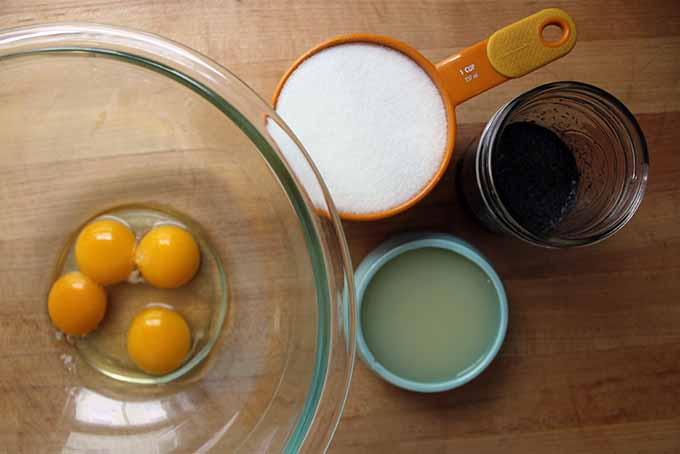
You only need about one inch of water in the bottom of your pot. Too much water could bubble up around the top of your bowl, plus it will take longer to heat. Bring the water up to a simmer.
If your bowl doesn’t nest well and you notice a lot of steam escaping, just keep an eye on the water level – you can always add more if the level gets too low.
Step 2 – Mix tea and water
Cut open your teabag and mix the contents with 1/3 cup hot water in a small cup or bowl. This recipe uses the full contents of the teabag!
The tea leaves add a nice flavor and texture to the final result.
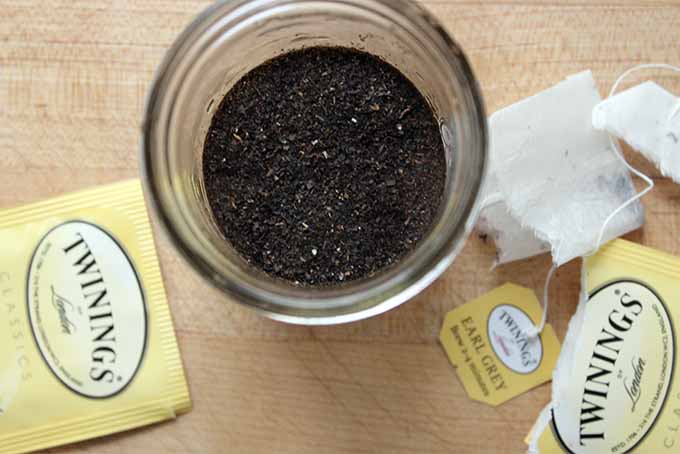
You don’t need to worry about using boiling water here. Most of the flavor will be extracted as the curd cooks, so hot water from the tap will do just fine.
Let the tea sit for about ten minutes before adding the eggs and sugar.
Step 3 – Whisk together the sugar and eggs
Whisk together the sugar and eggs in the bowl you will use for your double boiler. Make sure these are thoroughly whisked before adding in the juice, otherwise the acidity could curdle your eggs!
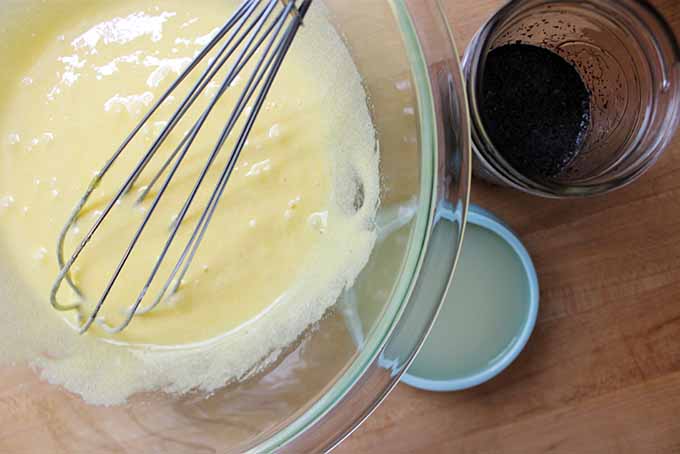
If this does happen, it’s not the end of the world. If you choose to strain the final product, any curdled bits will be removed, leaving you with a smooth spread.
Once your eggs and sugar are thoroughly combined, add in the lemon juice, salt, and steeped tea. Whisk these together well.
The tea leaves might sink to the bottom of the bowl. This is okay – as the mixture cooks and thickens, they will become more evenly distributed.
Step 4 – Cook the curd
Cook the curd over your double boiler on medium-low heat – your water should maintain a low simmer. Be sure to stir constantly with a rubber spatula.
You want to be sure to scrape the curd from the bottom of the bowl as well as the sides. Stir regularly to avoid uneven cooking. You don’t want overcooked curd on the bottom, and raw on top!
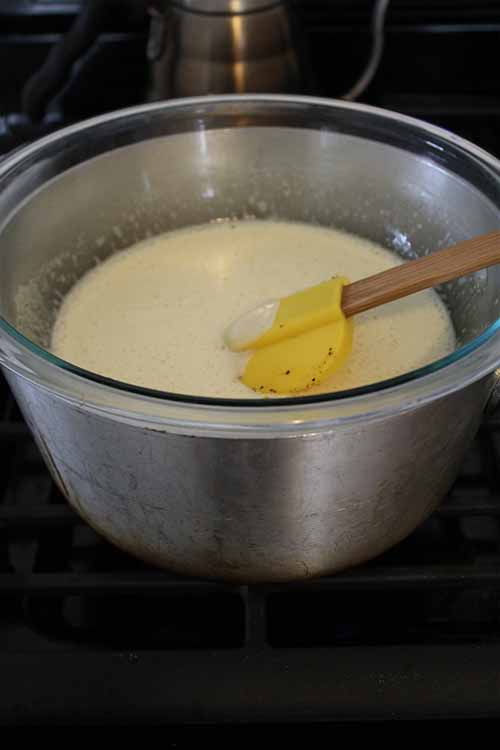
The proteins in eggs begins to set at 160°F, and they curdle at 180°, so aiming for 170° is the ideal temperature.
If you do not have a kitchen thermometer, a great way to check for doneness is to drag your spatula through the middle of the mixture. If the curd holds a line where the spatula was dragged through, it is done.
Step 5 – Add butter
Once your curd has reached 170°F, turn off the heat and add the butter to the bowl. Let this sit for about 5 minutes as the butter melts.
Once melted, stir the curd until well combined.
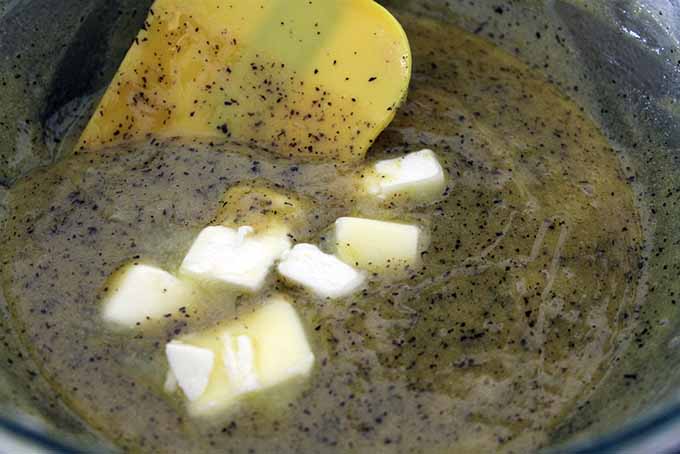
Step 6 – Blend or strain
The best way to emulsify the butter into the curd is with the help of an immersion blender.
If you’re wondering whether an immersion blender is a worthwhile investment, the answer is yes, without a doubt. I use mine multiple times every day. Our guide to immersion blenders can help you choose the best model to fit your needs.
If you don’t have an immersion blender, passing the curd through a strainer or chinois can help incorporate the butter as well. However, this does not do quite as thorough of a job (and it will remove all of those nice flecks of tea). Once cool, your final curd might have a bit of a grainy texture to it.
Chill your curd in an ice bath. To do this, transfer your curd to a clean bowl nested in a larger bowl of water and ice. Stir every 15 minutes until the mixture is chilled all the way through, for about an hour.
If the bowl begins to overflow as the ice melts, periodically pour off some of the water and replace with more ice.
You can press a piece of plastic wrap lightly against the surface of the curd to avoid forming a skin as it cools. Do not create a seal, however, as this will trap steam that can loosen the texture of your curd.
Uses for Curd
Once your curd is finished, you have dozens of options for how to use it – as a dip for fruit or a topping for yogurt, spread on toast, biscuits, or scones.
There are also plenty of other fun recipes that use curd as the base. The following are a few of my favorites:
-
Fruity Frosting
Fold some curd into buttercream for a vibrantly flavored frosting.
-
Icebox Pie
Scoop your curd into a pre-baked pie crust. Top with whipped cream, and freeze for at least two hours to set.
-
Semifreddo
Translating from Italian as “half-frozen,” this simple dessert has a texture similar to ice cream, but it is much simpler to make!
You can scoop it, freeze it in molds, or slice it like a frozen loaf. Stay tuned for more about semifreddo in an upcoming post!

-
Dessert Tart
Scoop your curd into a pre-baked tart shell. Bake for an additional 10-20 minutes at 300°F.
The baking time will vary based on the size of your tart shell, but you are looking for the filling to set around the edges while it remains slightly loose in the middle. Chill in the refrigerator for an hour before serving.
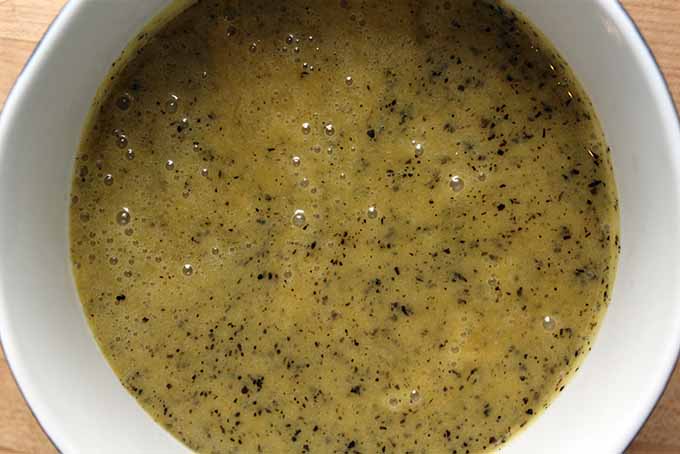
Have you ever made homemade curd before?
What’s your favorite flavor combination? How else have you served it? Let us know in the comments below!
And for more spreadable sweets to smear over your favorite pastries, try these recipes next:
Photos by Kendall Vanderslice, © Ask the Experts, LLC. ALL RIGHTS RESERVED. See our TOS for more details.
About Kendall Vanderslice
Kendall’s love of food has taken her around the world. From baking muffins on a ship in West Africa and milking cows with Tanzanian Maasai, to hunting down the finest apfelstrudel in Austria, she continually seeks to understand the global impact of food. Kendall holds a BA in Anthropology from Wheaton College and an MLA in Gastronomy from Boston University, and has worked in the pastry departments of many of Boston’s top kitchens. Based in Somerville, Massachusetts, Kendall helps to run a small community supported bread bakery and writes about the intersection of food, faith, and culture on her personal blog, A Vanderslice of the Sweet Life.



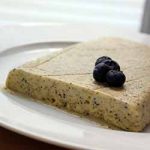
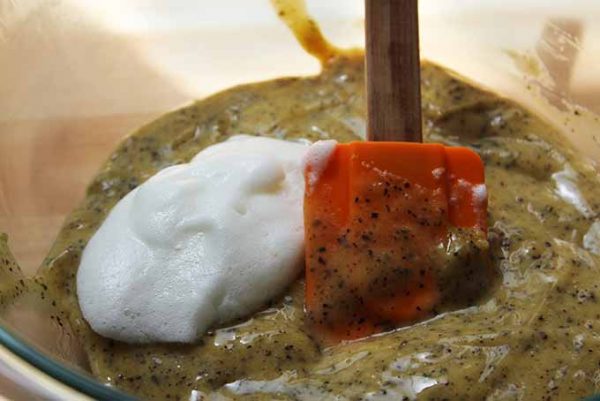
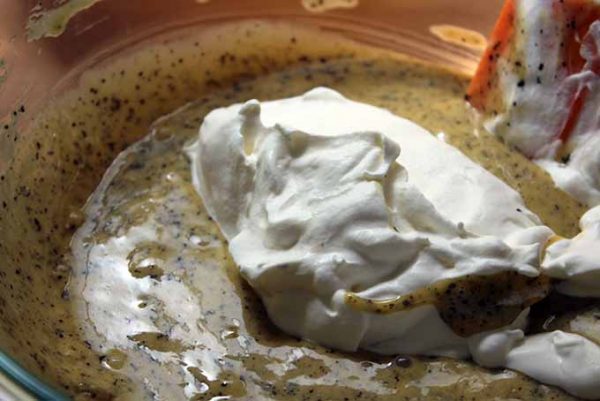
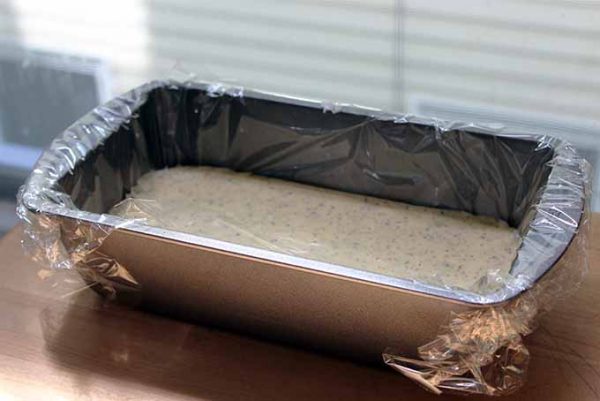


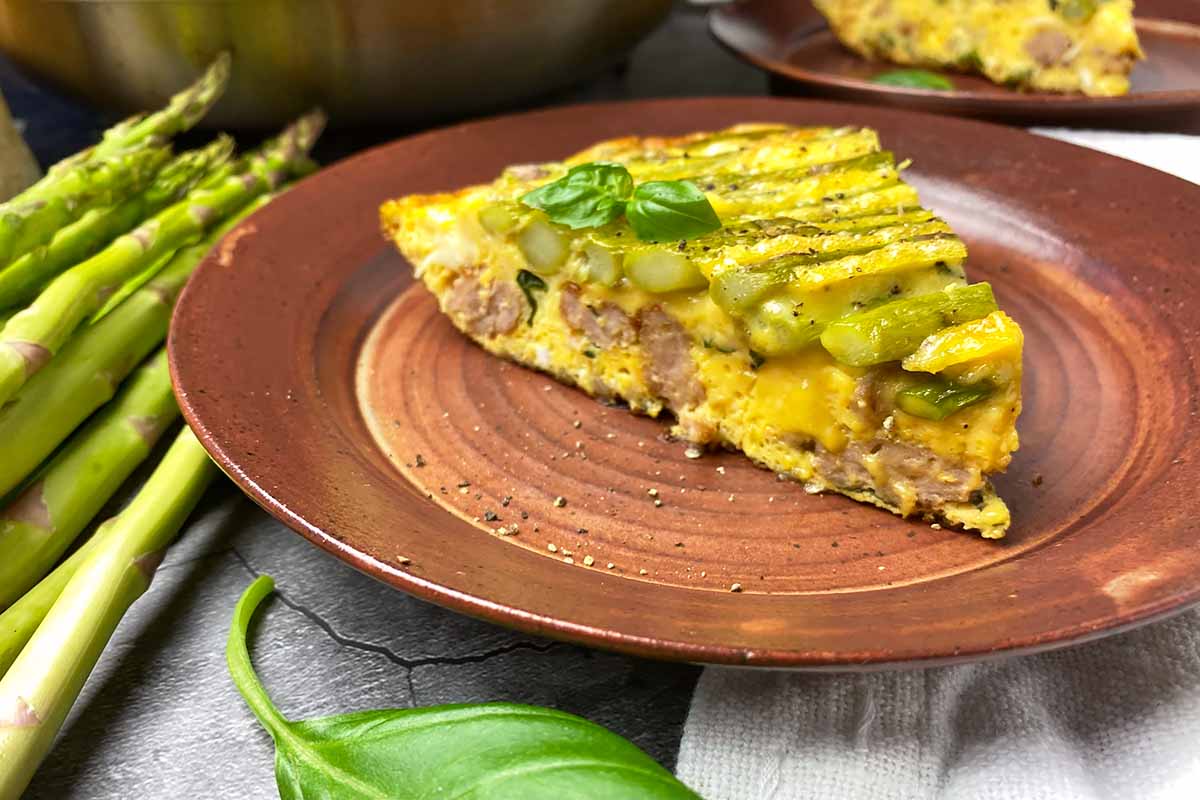
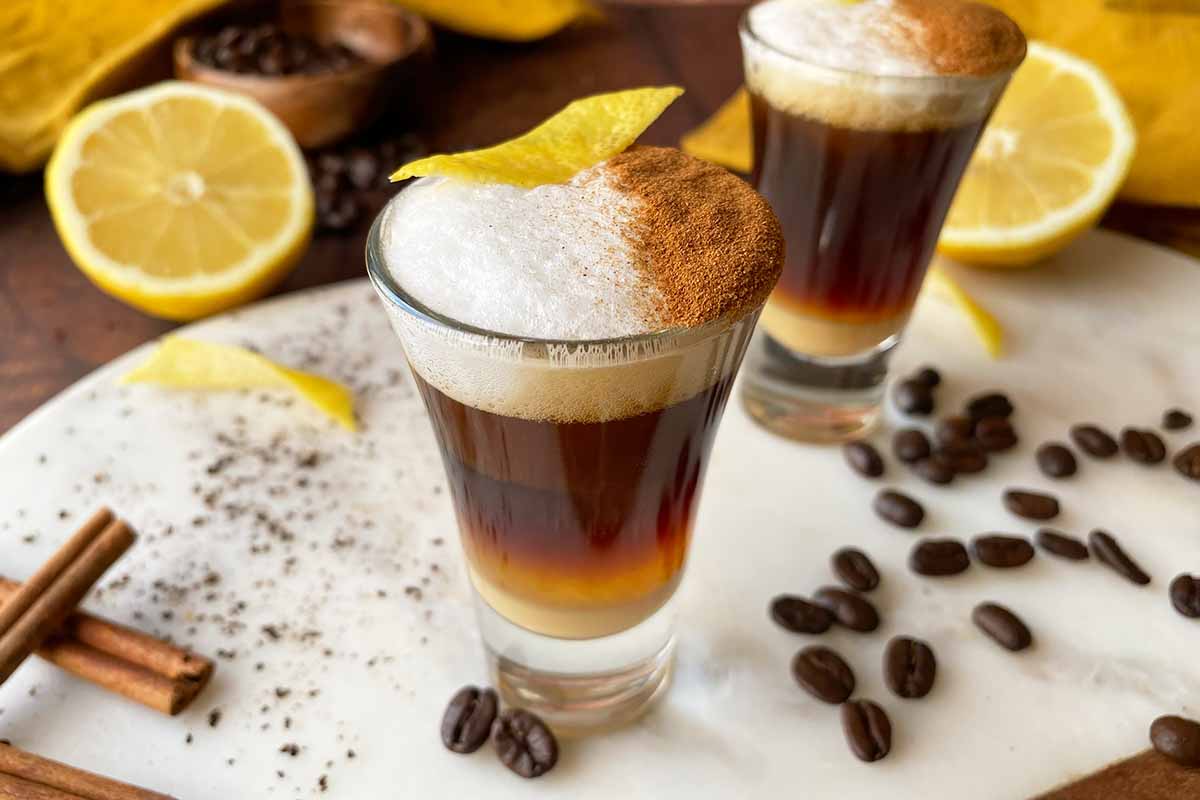
This looks so good! I love making homemade curd because it always tastes the best to me 😀 I’ve actually never thought to try using tea and incorporating that into curd, but according to your recipe, it sounds delicious. Can’t wait to try this delicious treat!
This looks so beautiful! I imagine it would be excellent with a variety of fruit flavors. What I really like about this is how it seems like it will lend itself to so many different uses. I actually didn’t know that curd meant anything other than the stuff you make from curdled milk. This is quite a revelation. It’s mango season at the moment and I have half a dozen mangos from the tree right outside my balcony. I think I’m definitely going to try a mango flavor first.
How lucky are you, to have a mango tree right outside of your home. I’m a little envious of you right now. Hey, don’t forget to share your results with us.
Wow, that looks so good! As a lover of tea, I’ve always wondered what else I can do besides just drinking it. I’m not much o a great cook, but I will be trying this. I never even tried to make a cake once, so we’ll see how this goes! I also like the fact that this recipe uses no milk, so i don’t have to look for a replacement.
Wow, that looks so good! Im not a houge lover of tea, I am an average cook, this should be easy.
Thanks for the recepie! 😀
Rajko
I’m not sold. Maybe I’m just to picky. I think I’ll stick to drinking my tea.
Wow, thank you for making such accessible instructions for this. I’ve never attempted to make a dish like this myself; I’ve tried it in restaurants and thought this must be the kind of recipe for professionals. But this looks like something I could actually try. I love Earl Grey tea, I think this would be an amazing thing to serve at a brunch or afternoon get-together.
I’m pretty sure I wouldn’t like this at all! It doesn’t look appetising at all, and I imagine the texture to be pretty unpleasant too. This one is a definite non-starter for me.
Must say, looks divine…And I bet it tastes that way too!
I love me some well made curd, and this looks absolutely fantastic, the next time I make a batch, I definitely need to try this recipe out, especially since I’ve been on a somewhat earl grey addiction, something about the taste of bergamot just really calms me down and helps me relax.
I tried a similar kind of curd at a restaurant and I thought that it was really difficult to make, looking at this article it doesn’t seem that complicated so I may give it a try! I loved the taste, I think it’s the perfect breakfast and it’s even good for brunch.
I have seen curd options on some restaurant menus, but I think that I never really took the time to ask what really was, but now I’m amazed by this idea, I had no idea that you could use tea in order to make a dessert like this, I can imagine the classical touch that it can add to it, yum! And it’s also a really good thing that you can make it variate, that way you can have curd for days without really getting bored of it, without mentioning that all of those fruits looks amazing.
Thanks for sharing!
Well I think I am really missing out here, because I am not sure if I have ever had a curd before, or some curd, however you say it. I am betting that I have and that it might have just been called something different, and maybe there is a cultural gap here. It sounds delicious though, either way, and looks good in that semifreddo.
I’m sorry to hear you’ve missed out on this delicious custard until now! I hope you try it, it’s very delicious!